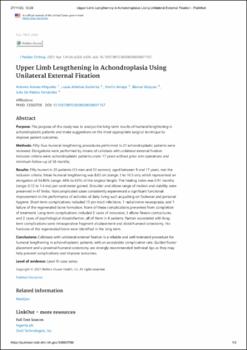Upper Limb Lengthening in Achondroplasia Using Unilateral External Fixation

View/
Date
2021-04Author
Amaya, Martín.
Arenas, Antonio.
Arbeloa, Lucas.
Et al.
Metadata
Show full item recordAbstract
Abstract
Purpose: The purpose of this study was to analyze the long-term results of humeral lengthening in achondroplastic patients and make suggestions on the most appropriate surgical technique to improve patient outcomes.
Methods: Fifty-four humeral lengthening procedures performed in 27 achondroplastic patients were reviewed. Elongations were performed by means of callotasis with unilateral external fixation. Inclusion criteria were: achondroplastic patients under 17 years without prior arm operations and minimum follow-up of 36 months.
Results: Fifty humeri in 25 patients (13 men and 12 women), aged between 9 and 17 years, met the inclusion criteria. Mean humeral lengthening was 8.82 cm (range: 5 to 10.5 cm), which represented an elongation of 54.80% (range: 46% to 63%) of the original length. The healing index was 0.91 months (range: 0.72 to 1.4 mo) per centimeter gained. Shoulder and elbow range of motion and stability were preserved in 47 limbs. Noncomplicated cases consistently experienced a significant functional improvement in the performance of activities of daily living such as putting on footwear and personal hygiene. Short-term complications included 11 pin-tract infections, 1 radial nerve neuropraxia, and 1 failure of the regenerated bone formation. None of these complications prevented from completion of treatment. Long-term complications included 2 cases of nonunion, 3 elbow flexion contractures, and 2 cases of psychological dissatisfaction, all of them in 4 patients. Factors associated with long-term complications were intraoperative fragment displacement and distal humeral osteotomy. No fractures of the regenerated bone were identified in the long term.
Conclusions: Callotasis with unilateral external fixation is a reliable and well-tolerated procedure for humeral lengthening in achondroplastic patients, with an acceptable complication rate. Guided fixator placement and a proximal humeral osteotomy are strongly recommended technical tips as they may help prevent complications and improve outcomes.
Level of evidence: Level IV-case series.
Copyright © 2021 Wolters Kluwer Health, Inc. All rights reserved.
Collections
The following license files are associated with this item:

